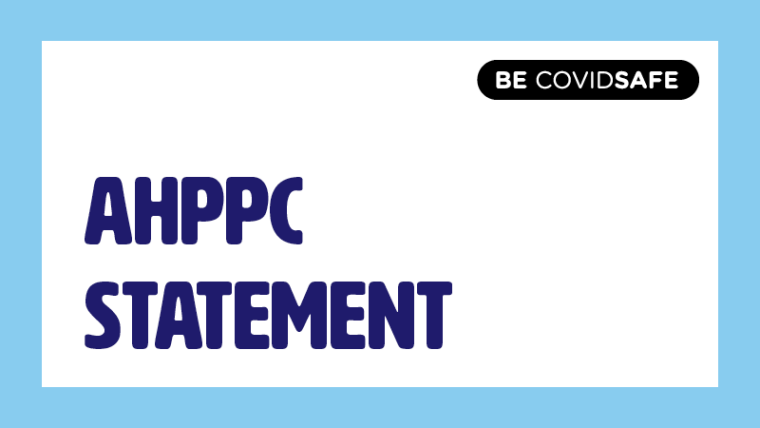
Refining Australia’s public health strategy
Australia is undergoing a period of transition as we move from a national strategy of suppression with a goal of no community transmission, to a ‘living with COVID-19’ context, where the community is able to function more normally and disruptions to society and the community are minimised. When living with COVID-19, our health goals shift to controlling transmission in order to prevent serious illness, hospitalisation and death. This will protect health system capacity and ensure sustained capability to manage the demands of COVID-19, whilst maintaining access for the community to the full range of health care including prevention services, and aiming to achieve broader societal, economic and educational goals.
The COVID-19 response transition continues to require close monitoring of the epidemiological situation and health system metrics, and integrating learnings from the international and local experience. This will guide implementation of proportionate public health measures. Consistent with the Doherty modelling for National Cabinet, case numbers are expected to increase across the country as restrictions ease and borders reopen, public health measures will aim to limit transmission, ‘flatten the curve’ and prevent serious illness, and protect vulnerable populations.
What we know about Omicron
The impact of Omicron on the progress of the pandemic is not yet clear although the signs of another epidemic wave are being seen in many countries, including Australia. While the variant has a large number of genetic mutations the impact of these mutations on key epidemiological characteristics is uncertain. Information on intrinsic transmissibility of the variant, disease severity and the effectiveness of current vaccines and treatments against transmission and clinical severity is emerging. The Department of Health is developing regular situation assessments and reviewing evidence as it becomes available. Evidence indicates that Omicron is substantially more transmissible than Delta in populations with a high previous exposure to COVID-19 and/or high vaccination coverage, with most recent estimates demonstrating that the number of cases doubles every 2-3 days. This suggests escape from vaccine and/or naturally derived immunity. Recent small studies indicate a reduction in laboratory indicators of vaccine protection compared to the ancestral and Delta variants and limited real world studies are also consistent with this finding. The efficacy of current vaccines to prevent serious disease from Omicron following a primary course is not yet known and requires further investigation. The combination of high transmissibility and vaccine escape may lead to rapidly escalating transmission in the context of high vaccine coverage and a significant caseload with the potential to strain health system capacity, even if disease severity is intrinsically reduced compared with previous strains.
Public health implications
Within a ‘living with COVID’ context, it is a priority to continue to slow transmission of Omicron into the community until more is known about the virus, and existing plans and public health responses can be adjusted accordingly. Given the emerging evidence on boosters, continuing to slow transmission is also important while the vaccine booster program is rolling out in line with ATAGI’s recent recommendation to bring the booster dose interval forward from 6 to 5 months. Australia is in a good position with one of the highest fully vaccinated populations in the world. The timing to provide optimal protection for Omicron remains uncertain and only a small proportion of the fully vaccinated population has recently become eligible to receive a booster dose to date. Small sections of the population also remain unprotected (e.g. vaccine hesitant) or under-protected (e.g. single dose vaccinated, immune compromised). The 5 – 11 year old vaccination program is to commence on 10 January 2022.
We have been successfully moving through the National Plan to transition Australia’s National COVID-19 Response (National Transition Plan), with surge responses limited to communities with lower vaccination coverage, and no instances of demand overwhelming health system capacity thus far. However, a rapid increase in cases and/or potential changes in disease severity associated with Omicron – including amongst vaccinated individuals may impact on anticipated health system demand which has flow on effects to timely health care for all conditions. Proportionate measures are needed to prepare Australia to manage Omicron whilst continuing to safely progress the National Transition Plan.
Omicron is anticipated to become the dominant variant in Australia soon. There remains considerable community transmission of the Delta variant. Due to the increased transmissibility of Omicron and anticipated high case numbers in the short to medium term, the combined impacts of Delta and Omicron could cause increased demands on the health system including primary care. A particular impact is more likely to occur in sensitive settings such as aged care, disability care, correctional facilities, culturally and linguistically diverse communities and remote Aboriginal and Torres Strait Islander communities.
Response options
A proportionate and measured application of public health levers will slow transmission of Omicron into the Australian community. This delay will allow time to learn more about the variant to inform future management, to increase uptake of booster doses, achieve good vaccine coverage of those aged 5 – 11 years, and encourage those who are unvaccinated or not yet fully vaccinated to access the program. A combination of measures is intended to control transmission without significantly restricting Australia’s freedoms. Implementing some of these measures now is intended to reduce the risk of requiring more restrictive measures in the longer term if the combination of Delta and Omicron variants were to result in a significant surge of cases with clinical illness requiring hospitalisation and other clinical care.
AHPPC recommended response options
The AHPPC, having considered the current context with the need to await further evidence regarding the impacts of Omicron, have agreed on several interim response options:
- Recommending indoor face masks – the AHPPC has agreed a recommendation for wearing of facemasks in indoor settings, noting that this is a particularly important in high risk settings. Face masks have a minimal impact on individuals and the economy, provide confidence to the community, and have shown to be beneficial in reducing transmission of disease. Masks should be mandated in all indoor settings including retail, hospitality when not eating or drinking, and entertainment facilities. Implementation of mask wearing measures should occur prior to Omicron case escalation to have maximum benefit.
- Increase vaccination coverage including boosters – the AHPPC has reiterated the need to ensure those who are partially vaccinated complete their courses and those who remain unvaccinated are encouraged to undergo vaccination. The AHPPC has agreed that booster doses will play an important role in reducing transmission and severity of the Omicron variant, based on currently available evidence. Public communications will need to reflect the importance and urgency of receiving booster doses once eligible. The AHPPC notes the updated booster advice reducing the dose interval to 5 months and notes ATAGI will continue to monitor the evidence and update its advice accordingly. AHPPC understands that ATAGI will consider whether a three-dose rather than a two-dose course meets requirements for full vaccination status, noting that there will be significant considerations for implementation if this definition changes
- Maintaining test, trace, isolate and quarantine (TTIQ) – the AHPPC has requested that the Communicable Diseases Network Australia (CDNA) consider current TTIQ requirements for Omicron particularly within sensitive settings. It is important to note that while TTIQ has been demonstrated to be effective, it is limited by operational factors and the community’s willingness to be tested and comply with public health recommendations where required. Therefore, the overall contribution of TTIQ to limiting transmission will decrease with higher case numbers. This may lead to a requirement in the future to rely more heavily on other levers, including indoor mask wearing and strategic use of rapid antigen testing, to control transmission and impacts, particularly in high-risk settings.
- Adjusting the international current travel ban – the AHPPC has noted that Omicron has now spread beyond those countries initially included in the current travel ban. The AHPPC has recommended not extending this travel ban as the number of countries where Omicron is present is rapidly increasing, and instead removing the initial travel ban and considering maintaining some universal international border measures such as post arrival testing and/or quarantine (see Table 1 for detail). Any measure that is implemented should be continuously reviewed against the local context and particularly local rates of transmission to ensure it is proportionate to risk.
- Developing specific strategies to protect vulnerable settings and individuals – the AHPPC recognises that in the context of community transmission specific strategies will be needed to protect vulnerable settings and those who work or visit these. These may include increasing or expanding use of rapid antigen testing (RAT) in settings such as aged care facilities, clear messaging to individuals at higher risk of severe disease to ensure they are fully vaccinated and have accessed a booster dose and ensuring access to therapeutics.
As local transmission increases, border measures become less important and other measures will need to be adjusted to ensure they are proportionate to the current context, whilst also maintaining health system capacity. The AHPPC will continue to consider other available response options as further evidence on Omicron emerges. Careful communications with the public will be needed to support engagement and compliance during this period of transition.
Levers of control | Recommendations | Considerations |
Public health and social measures | Require universal use of facemasks indoors
|
|
Introduce and/or maintain minimal to moderate public health and social measures to decrease contact rates in the population
|








